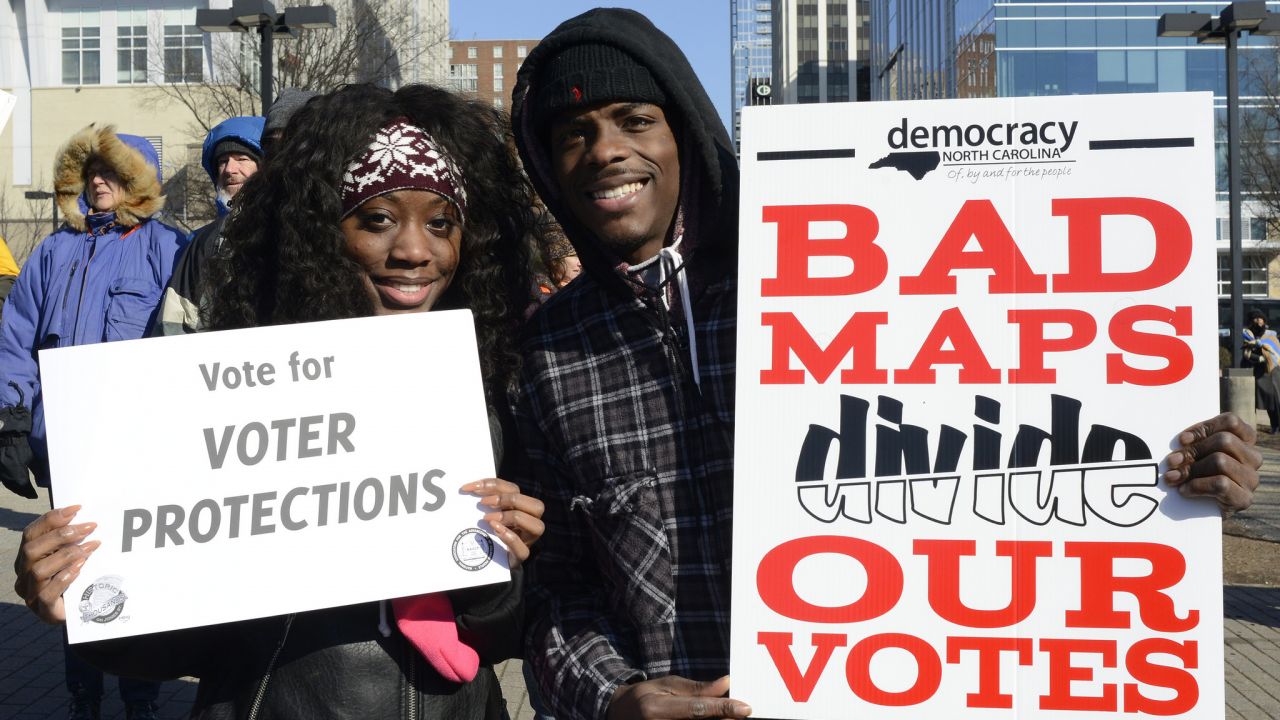
Social justice activists mobilized by the Moral Monday Movement rally in downtown Raleigh, NC on February 13, 2016. (Photo: Stephen Melkisethian/flickr CC 2.0)
Democrats are daring to dream. A sit-in by House Democrats to demand action on post-Orlando gun control measures energized party faithful, dominated social media and may have generated enough public pressure to splinter the Republicans’ near-solid fealty to Second Amendment absolutism.
It also encouraged many Democrats to set their sights on something long considered impossible — taking back the House, where Republicans and Speaker Paul Ryan hold an historic 247-188 majority. Clinton has even made her guarantee of a Democratic Congress into an instant applause-generator on the stump.
But the map for the House of Representatives looks very different.
As strong as Hillary Clinton looks against Donald Trump four months before Election Day — data whiz Nate Silver now gives Trump less than a 30-percent shot at beating the former secretary of state, and projects Clinton has almost 325 Electoral College votes sewn up — 2016 is not looking like a Democratic wave year.
This is a fool’s errand. The Republican firewall in the House can survive even Donald Trump. Indeed, it was painstakingly designed to keep the House red even in the face of a Democratic landslide. The reason why? The oldest trick in the book — the gerrymander — which Republicans used in a thoroughly modern and masterful new way after sweeping 700 state legislative seats in 2010, and taking control of two-thirds of all state legislative chambers nationwide.
The Constitution mandates that every congressional and state legislative district be redrawn after the census, so elections in “zero years” can reverberate throughout the decade. The maps the Republicans drew in 2011 — especially in blue and purple states like Pennsylvania, Michigan, Wisconsin, North Carolina and Ohio — have been carefully crafted with sophisticated algorithms and reams of demographic details such as to be virtually impregnable. Even against a Democratic wave.
The maps paid immediate dividends in 2012, when Barack Obama was re-elected. Democrats took 25 of 33 Senate seats, and Democratic House candidates won 1.4 million more votes than Republicans — but the GOP held the House, 234-201.
In Pennsylvania, Democratic House candidates won 100,000 more votes than Republicans, but the new lines were artfully packed into so few districts that the GOP claimed 13 of the 18 seats. In Michigan, 240,000 more voters favored Democrats, but the delegation went 9-5 Republican. Barack Obama won Florida by almost 3 percentage points, but he only won 40 percent of the tilted congressional districts. Ohio voters narrowly favored Republican House candidates — but the unforgiving lines turned 12 of the 16 seats red. That means 52 percent of the vote became 75 percent of the seats.
Similar stories played out in Wisconsin, North Carolina and many other states. While nationally, 1.4 million more voters cast ballots for Democratic House candidates, the lines were so stout that the GOP lost just seven seats. Republican strategists took a victory lap after the 2012 results, noting that they’d managed to “erect a Republican firewall through the redistricting process.” Indeed, for the first time since 1972 — and just the second time since World War II — the party with the most votes did not take control of the chamber.
Democrats are hoping that 2016 will be different, but this is wishful thinking. In Florida this week, an optimistic Democratic Congressional Campaign Committee went so far as to reserve six figures’ worth of TV time in the pricey Orlando market to target veteran Republican lawmaker John Mica, who rolled to victory in 2014 with 63 percent of the vote. The only reason he’s vulnerable is because a Florida judge ordered his radically gerrymandered district to be redrawn last year. Trump doesn’t jeopardize this seat. If the Democrats capture it, it’s because it was un-gerrymandered. This seat is in play only because it’s the rare district where a judge forced an untilted, fair map.
Democrats are also imagining that Trump could drag down GOP incumbents in suburban districts in Minnesota, New Jersey and California, and that he inspires so many Latinos to vote against him in states like Texas that even more seats are put in play. Some Republicans are concerned about this as well. In a recent column, National Review editor Ramesh Ponnuru warns, “Republicans should worry about losing the House.”
Unfortunately for Democrats, there just aren’t enough competitive districts for any serious challenge to Ryan’s speakership. Nationwide after 2010, Republicans took complete control of drawing 193 districts. The Democrats drew just 44. The GOP specialized in taking “swing districts” off the table. Of the 70 districts dubbed “competitive” by NPR in 2010, Republicans redrew 47 of them in 2011 — and aimed to take them off the table for the next decade.
Earlier this year, The Cook Political Report identified 31 Republican seats as at risk. Democrats would need to take 97 percent of those districts to win the House — without losing any of their own. You’d have to be a character in Dumb & Dumber to look at those odds and think, “So you’re telling me there’s a chance.”
There’s not. There might be a “Never Trump” movement within some wings of the GOP. But there is no movement to put the Democrats in charge of the government. An NBC/Wall Street Journal poll last week found Clinton taking control of battleground states — but a 46-46 tie when voters were asked which party they wanted to control Congress. When voters were asked the same question in June 2008, when Democrats retained the House, on that same question the Democrats held a 52-33 advantage.
If polls show a looming Trump debacle by late summer, the smart Republican money simply moves down-ballot as an insurance policy. The deep-pocketed GOP donors now seemingly snubbing Trump will simply focus their money on securing the House and attempting to save the Senate. It need not be an expensive policy: In his latest Crystal Ball study last week, the respected political scientist Larry Sabato rated only nine Republican incumbents as holding “toss-up” seats. His Center for Politics report rates 227 GOP seats as safe, likely or leaning GOP. It takes only 218 to control the chamber.
In this age of hardened partisanship, Americans just don’t split their tickets any more. Is it possible that this fall, Republicans turned off by Trump will hold their nose and vote for Clinton, support a Libertarian ticket with two former GOP governors or just stay home? Sure. But to think that many millions of them — enough to rebalance a deeply undemocratic map — will also support Democratic congressional candidates and give Clinton a chance to govern with a Democratic Congress is the kind of political fantasy we must dispense with.
Cable news panels, from now through November, will ceaselessly debate whether the Democrats have a chance at taking back the House. It’s a waste of time. What we need to be talking about instead is how to reform a system that makes partisan mapmakers more powerful than a popular majority.




